Jane Ingram Allen
Made In Taiwan
Pingtung County
Jan. 9 –
22, 2005
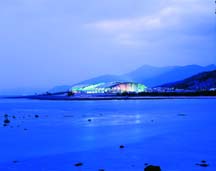

Host Organization: National Museum
of Marine Biology and Aquarium
2 Houwan Rd, Checheng, Pingtung, 944, Taiwan
Web site: http://www.nmmba.gov.tw
Email: yhchen@nmmba.gov.tw
We have arrived at the Pingtung Aquarium. It was an interesting trip as the flight to Hangchun was cancelled due to high winds. We flew to Kaohsiung and took a bus to the Aquarium. The scenery along the ocean was very beautiful.
Once we arrived we had some lunch and then went to the bus station, no not to get on another bus, but to install Jane's site maps. The station has an art gallery and Jane's works were installed in the middle of the gallery as the walls have photographs of the area by another artist. We had lots of help with the installation and then went with one of the volunteer's to her home to have dinner with her and some of her friends. Afterward we came back to the very nice apartment that the Aquarium has provided. Our stay here looks to be getting off to a great start with lots of help and meeting wonderful people.


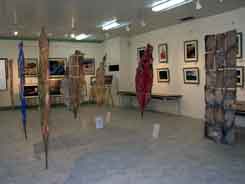
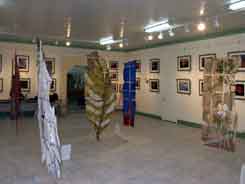

We are located during this two weeks at a one of the most beautiful places in Taiwan. This morning the clouds had blown away, and you could look across about 20 km of blue ocean water to the land on the other side of the cove where the Aquarium is located. Looking to the left we can see the mountain peeks coming down to the sea. On our second day in Pingtung we attended the opening of the Jane's exhibit at the bus station art gallery. Many county and city officials came to the opening and gave brief welcoming presentations. This program was followed by a speech from Jane thanking many people for their generous support of her "Made in Taiwan" project. She also talked with many reporters afterwards about her work. Following the opening reception we went to Kenting National Park visitor's center in search of plant books. We did find one that gives the scientific name of the plants from this area of southern Taiwan, and the Hung-chuen peninsula.


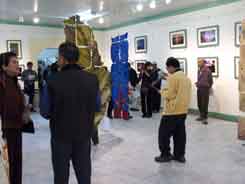
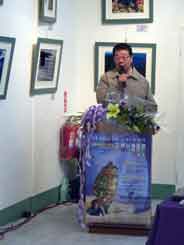
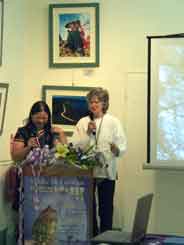
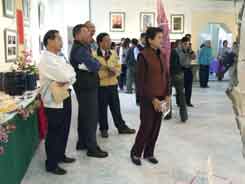
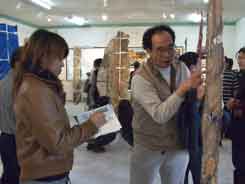
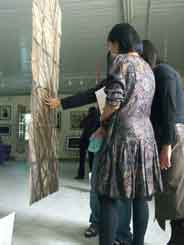
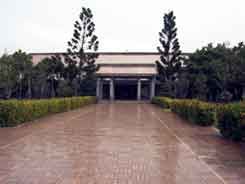
Today we spent time collecting the plants to be used for paper making. It appears that this southern end of Taiwan has many plants that may make paper. By the time we got back we had seven plants. These included the acacia tree and the schefflera. Jane and Tim began to prepare three plants to soak. It is great to have all of these volunteers to help with the picking, and there will be more to help prepare the plants, do the cooking, washing and beating of all the plant fibers we find in Pingtung area. Some volunteers from the community college in Hung-chuen who are doing natural dyeing with plants went with us to help look for possible papermaking plants. We went first to Spring Farm Nature Park to gather some plants and then to Kenting National Park Recreation Area to talk with the plant expert Dr. Wang Hsiang Hua, Director of the Forest Research Institute at Kenting. We are trying to get new and different plants that will make paper in each area, so at the end of the whole project we hope to have research about many plants of Taiwan that can be used to make paper.

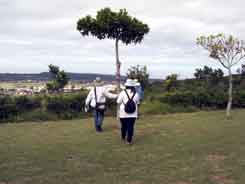

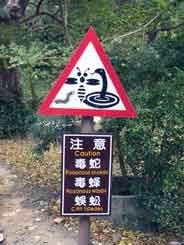
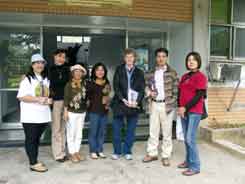

Today we had many volunteers who helped with cutting, cooking and beating the plant materials. We were able to get three cooked, two of them beaten and made small samples of paper. One of the ones we tried was acacia tree bark, and it made a rich brown colored paper. The volunteers were very excited about what could be done with the materials. Also, it was the first day for open studio and more than 25 people dropped by to see what was happening and watch Jane demonstrate papermaking. We also had our first experience of riding on a motor scoter. Tim drove while Jane tried to hang on the back. She is very reluctant to ride again because her legs are too long but maybe will get used to it!
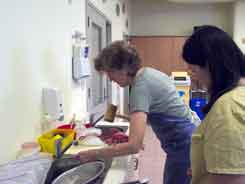
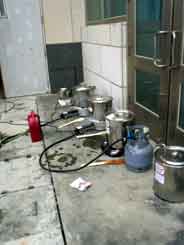
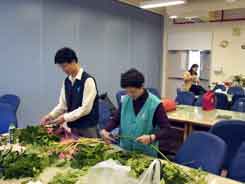
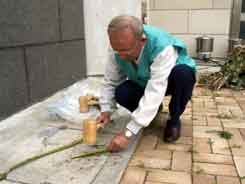

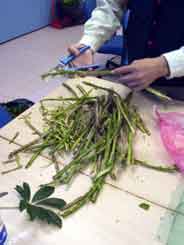
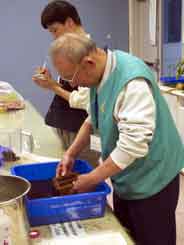

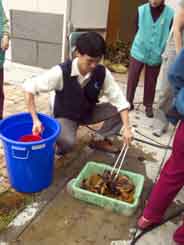
We decided to work in the morning making paper and preparing more of the plants of Pingtung area and then go out during the afternoon to see more of the Hangchun and Kenting National Park area. Jane worked with the key volunteer, Tiffany, to plan the day and then we started cooking plants that had been soaking overnight. We were also able to beat a couple of plants that were cooked from the previous day. All together we have 12 possible plants to test for paper making quality. One of the plants is seaweed. It appears to not have fibers that will form paper. After lunch we visited the white sand beach and Jane poured some paper on the sand. We will be back tomorrow to pick it up. As we drove I spotted what appeared to be grain on the road. It turned out to be sorghum that was being separated from the chaff by cars driving over it. We had seen picture of this in Kinmen but we find it happening here.... We also visited some of the most scenic parts of Kenting National Park, the south west ocean view area. This had the rock call a "cat's head" as it looks like such an animal. You be the judge, the picture is included below. There is also a rare picture of me with Jane; I'm more comfortable behind the camera. From there we went to a small fish market and then on to the Sisal Memorial Exhibit. Sisal was a major crop in Hangchun area, and until nylon was invented it was used to make howsere for ships and other rope products. It grows everywhere and was destructive to the primal forest that was cut to plant Sisal. Although the plant continues to grow everywhere, it is no longer a dominant industry. The Park also housed some Formosan Deer next to the Memorial. We returned to the Aquarium to start cooking the onion skins to see if they will make paper.
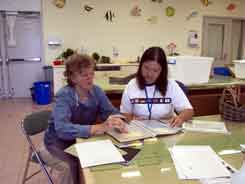


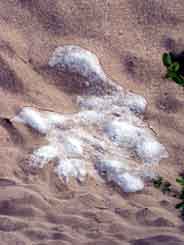

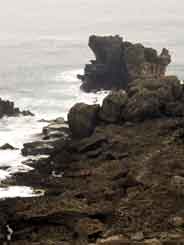
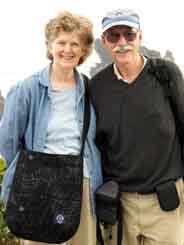
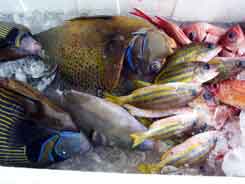


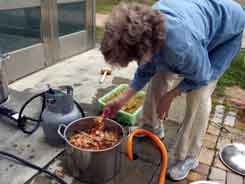
We seem to have set a pattern where we work in the morning and then go out after lunch to see the area. It is quite beautiful, particularly Kenting National Park. We did go out to pick up the paper Jane had poured yesterday on the white sand beach. Someone had stepped on the edge, but as a whole it was in good shape. It will be added to one of Jane's site maps to be done for Pingtung area. We went to the most Southern tip of Taiwan and saw the light house that marks this point. We then went up the east coast that has a great rocky coastline with occasional beaches. We followed a route that took us around the Southern part of Kenting National Park and returned to Hangchun. There we looked at the city gates and selected the North gate for Jane to put up her paper and get the impressions in the paper for her site maps. On the way back to the Aquarium, we stopped to take a picture of a circular sign that is surrounded by bamboo scaffolding. Bamboo seems to be used for most everything. We also took pictures of the roadside businesses that are selling onions. This is an area that grows almost all of the onions for Taiwan, and some are shipped as far as the US. When we got back, we installed four of Jane's site maps in the lobby of the research side of the aquarium. Jane had the help of David Chen, Chief of Education, who has managed our stay in Pingtung. Tomorrow is the first day of the papermaking workshop.

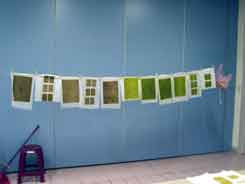
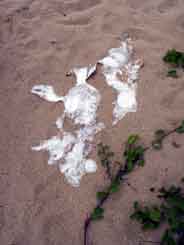
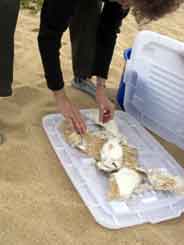
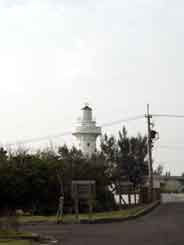
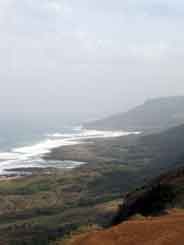
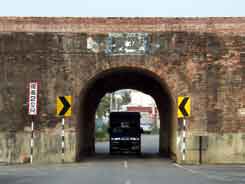
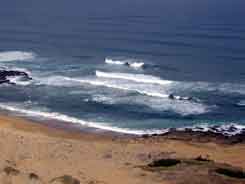
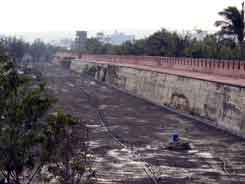
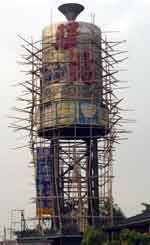
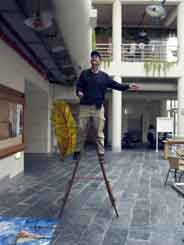
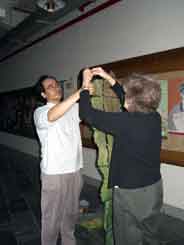
The papermaking workshop is going well. There are more than 25 active and interested students. Jane started the workshop with an introduction of herself and asked others to do the same. Many of those attending are teachers and volunteers. She then showed a Power Point presentation about making paper and how her work reflects some of the many ways to use papermaking for art and then demonstrated papermaking. The students helped with the process of preparing pulp from the plants--from cutting up leaves, stripping bark, cooking and then beating the fibers to actually making the paper. They created some very good and creative pieces of paper. After the workshop, we went to dinner at an excellent fish restaurant with our volunteer guide Tiffany. We then saw Kenting at night - more of a carnival environment with night market food booths and game booths.
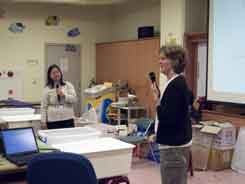


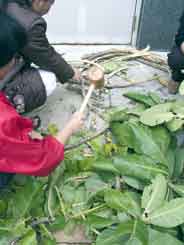
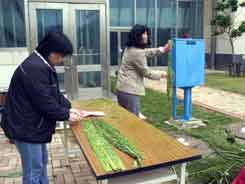
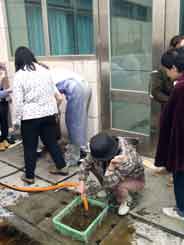
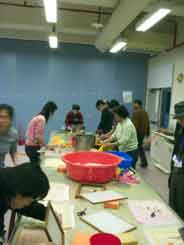


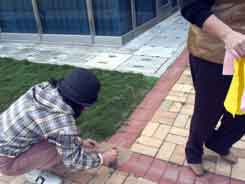
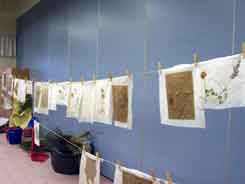
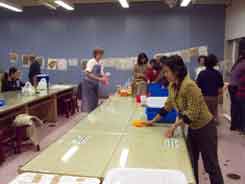
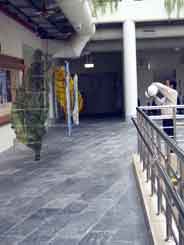
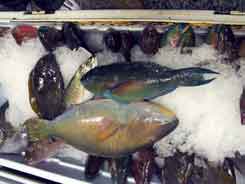

The last day of the workshop went very well. The students produced some exciting artwork, and they were very enthusiastic about what the learned about papermaking and the use of that paper. Overall, we have worked with 12 different fibers in Pingtung County. We still have the sisal plant fibers to beat and test. Sisal takes a long time to cook! lThe onion skins made paper with an interesting texture and color, but it has very short fibers. The students gave a gift of some books on the area, a calendar and a beautiful "Chinese" jacket for Jane. After the workshop, we went to Tiffany's house and had dinner with six Mormon missionaries stationed here in Hangchun. We returned home to the weekly duty of washing our clothes. Fortunately, the apartment complex where we are staying at the Pingtung Aquarium has a washer and dryer.
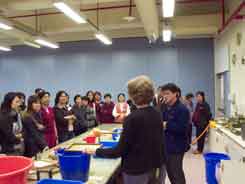


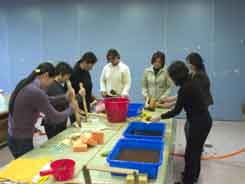

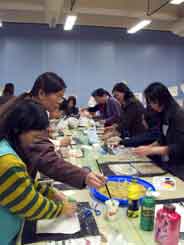
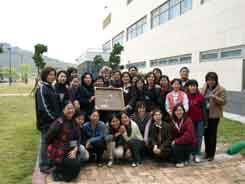
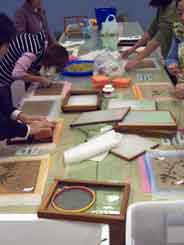
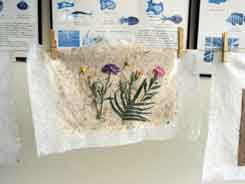
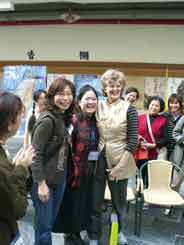
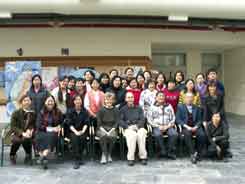
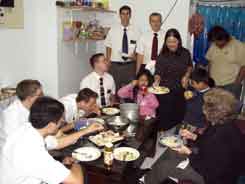
The day was spent making paper in preparation for Jane's closing exhibit on Thursday featuring at least one Pingtung site map. Jane always likes to have paper that comes from the local plants plus paper that represents some aspect of the community. Hengchun has an old wall and four gates that we were told are about 80% restored. Near the wall is a small park that has a contoured map of the wall and it's gates. Jane placed her handmade paper from plants of the area to dry on the map. She had a few watchers while doing this, and one was an older man who had worked in the sisal plant and knew about the plants for papermaking too. With a sunny day and a blustery wind, the paper dries quickly. We then went to a very large temple in the village of Checheng near the Aquarium. This temple had some metal drain covers in the plaza that had the name of the community. Jane placed her paper there. We also discovered relief images of lions that were on posts that prevented people from parking on the sidewalks. Jane used one of these, and it made a great paper lion relief. Speaking of lions, the temple had the largest entrance lions that we have seen - at least three meters long and two meters high. Because they are normally placed very near a building it is impossible to get a rear view of entrance lions but not in this case. It revealed to us the ease with which the Chinese address the body and functions of the body. It was was very apparent which lion was male and which was female. Upon entering the temple, which opens up four stories high - Jane pointed out an electronic sign that scrolled information. We both thought that this was another interesting cultural difference. Here people have no apprehension of blending modern technology into a religious setting. With our western "eyes" we found it unusual as it tended to clash with what we would think of as a sacred place. There was even one of the posters about Jane's "Made in Taiwan" project in Pingtung County displayed at the temple. Upon returning to the aquarium studio, Jane spent a couple of hours making paper from the local plants, one of which was sisal. It took eight hours to cook and when beaten and put through the blender made one of the best papers found here.
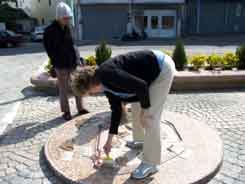

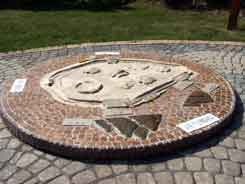

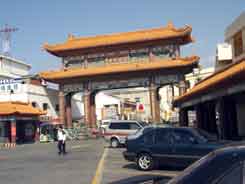
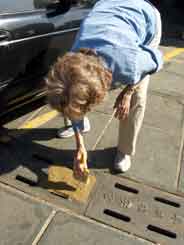

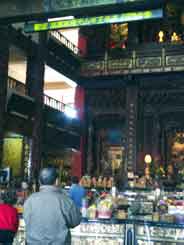

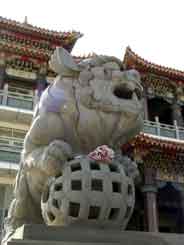
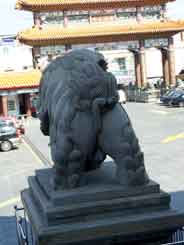


Today was largely focused on starting the two Pingtung site maps. Jane has an opening on Thursday so there is not much time to do anything except work. Tim had some time to see the aquarium. It is quite striking with its fresh and salt water exhibits. By Friday there will be time to look at the exhibits and other things around the area.
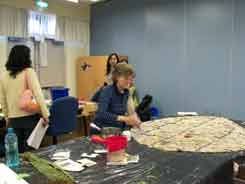
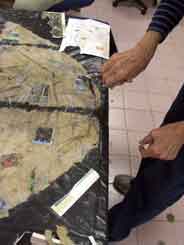
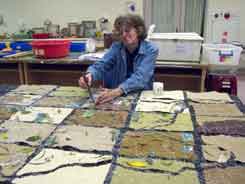
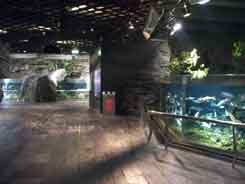

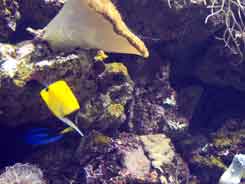
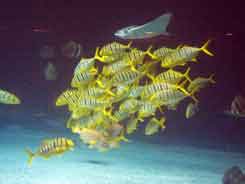


Today, Jane focused all of her attention on painting the two Pingtung Site Maps. She was able to do two sides of one and one side of the other. She will complete the last side of the second site map tomorrow before the opening of the final exhibition at 3 PM. We also had open studio today, and thanks to Tiffany, Jane did not have to break from painting to demonstrate papermaking. Tiffany did a very good job touring the groups through and explaining about the plants, having the children beat some of the fibers and demonstrating papermaking. The visitors also learned more about Jane's process by watching her work and having Tiffany translate. Jane also went to look at the Aquarium, as she is planning to paint fish on the last side to be done.
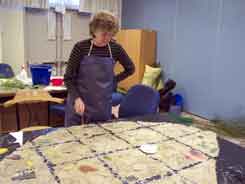
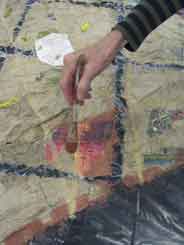


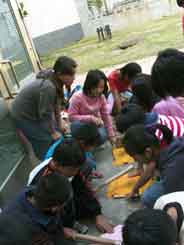

This is our last day of Jane's "Taiwan Site Map" Project in Pingtung County. The closing exhibit was held this afternoon at the bus station gallery in the city of Hungchen.. Jane had to work long hours these last two days to get ready for the exhibit. These exhibits are normally held on Friday, but this one was scheduled one day early because originally we were to leave on Friday. This morning Jane painted the fish side of the Kenting Site Map. She needed pictures of fish, so sent Tim into the Aquarium to take some photos of the most striking fish.. After lunch we rode the scooter back to the residency to change clothes for the gallery reception. We then went to the gallery and installed the two site maps and arranged the works made by community participants. The closing event included presentations of many thank you notes and small gifts from the students who participated in the workshop. Jane thanked everyone for being such good students and for making the time in Pingtung County so enjoyable, particularly Tiffany who has been there every day. The day ended with a great seafood dinner at a local restaurant with staff and volunteers from the National Museum of Marine Biology and Aquarium.
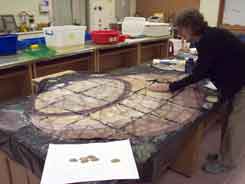
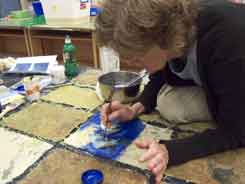
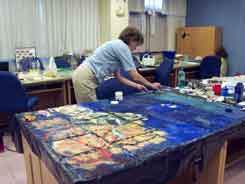

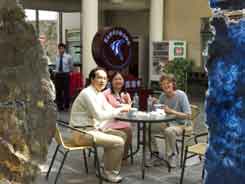
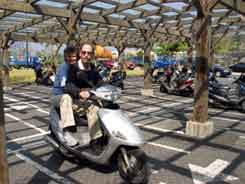
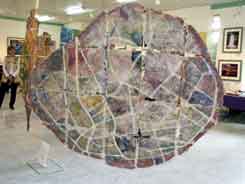


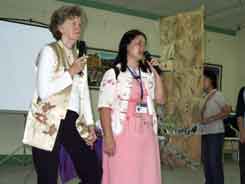
Return to Made In Taiwan home page
(updated on January 20, 2005 )
For more information on Jane, click on one of the icons below







